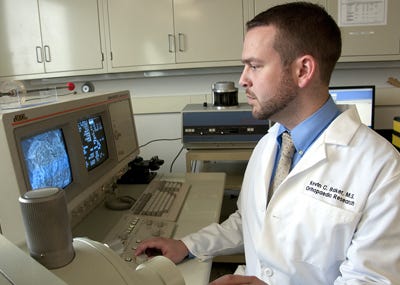Healing Broken Bones with Biodegradable Implants
October 30, 2015
Recent findings suggest a new synthetic biodegradable material could help heal bones in patients with orthopedic injuries.
|
Kevin Baker (Image courtesy of Beaumont Hospital) |
Kristopher Sturgis
Researchers at Beaumont Hospital (Royal Oak, MI) and Johns Hopkins are hopeful that a new experimental material could someday become a gold standard for patients who require bone replacement surgery after instances like tumor removal, spinal fusion surgery, or fracture repair.
However, the material--essentially a plastic derived from cornstarch and a volcanic ash compound known as Montmorillonite clay--still faces many experimental and regulatory hurdles.
The experimental material is created by injecting a polymer-clay mixture with carbon dioxide, resulting in an implant the resembles foam, but is actually rigid and porous like our bones. The biodegradable polymer was reinforced with Montmorillonite clay nanoparticles for strength, and could potentially dissolve in the body within 18 months.
"The polymer itself has very predictable degradation rates inside the body," says Kevin Baker, PhD, director at the Beaumont Orthopedic Research Laboratories. Baker has been working alongside Rangaramanujam Kannan, PhD, of Johns Hopkins to develop the unique material.
"The idea to reinforce the polymer with organically-modified Montmorillonite clay comes from Dr. Kannan's previous work developing polymer-clay nanocomposite materials. This leads to very high reinforcement of the mechanical properties of the polymer. This high strength is necessary when you are creating a material that needs to withstand the same loading that our bones do on a daily basis."
Baker and Kannan hope this new material can be used without the need for any additional permanent hardware placed into the patient's body. Many procedures today require metal or plastic supports for bone grafts--materials that carry the danger for potential infection, and can also complicate MRI and CT imaging tests in the future.
However the regulatory process for bone graft materials can be both lengthy and difficult. And the process becomes even more tricky when you're dealing with a technology that is among the first of its kind.
"The regulatory process for bone graft materials is arduous for a reason," Baker says. "We still have a great deal of preclinical testing that would be required before this would be approved for use in humans. Of course, the other challenge is that there really aren't any materials like ours that have achieved FDA approval."
Baker says they hope to continue their in vivo work in an effort to demonstrate the various abilities of the new technology. He believes the material could have great potential to heal fractures, fuse spines, and even fill bony defects. He's even hopeful that along the way, their work will lead to new ideas and developments that could push the technology to new heights.
"I think that if we choose the right testing framework and can demonstrate that our material achieves unique properties that can make a difference in the lives of patients, then we could find a partner willing to help us move this to market," Baker says.
Baker believes their technology could be a success because it provides a solution that is both reliable and efficient in improving patient care.
"This technology is extremely promising," he says. "We are hopeful that with the right partner, we can advance toward human use, and maybe even come up with a few new ideas along the way."
Learn more about cutting-edge medical devices at Minnesota Medtech Week, November 4-5 in Minneapolis. |
Kristopher Sturgis is a contributor to Qmed and MPMN.
Like what you're reading? Subscribe to our daily e-newsletter.
About the Author(s)
You May Also Like



